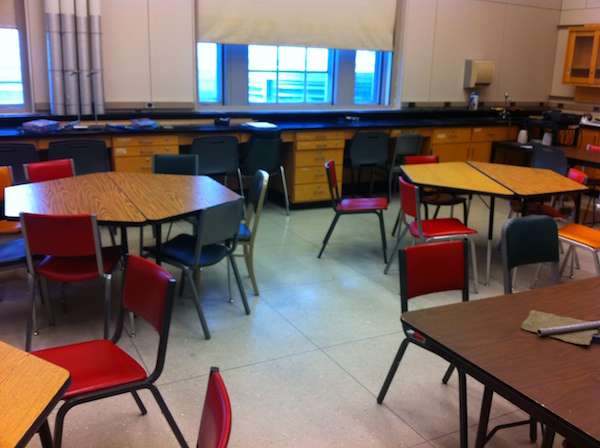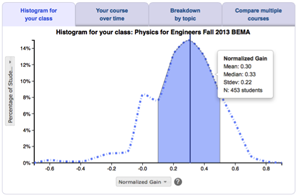SCALE-UP
Adapting to other environments
The What does it look like? section describes the canonical implementation of SCALE-UP as originally envisioned by the developers. However, SCALE-UP is incredibly flexible and can be implemented in a wide variety of ways. This section describes some of the most common variations that uses different approaches to satisfy the essential features of SCALE-UP.
Beyond undergraduate physics
SCALE-UP originally stood for Student-Centered Activities for Large Enrollment University Physics. However, because it is now used in classes of all sizes in many disciplines at many levels, the name has officially be changed to Student-Centered Active Learning Environment with Upside-down Pedagogies, to be inclusive of the wide range of environments where SCALE-UP is now used.
Other disciplines: Because the design of SCALE-UP is not specific to physics, it can be used in nearly any discipline. SCALE-UP has been used in physics, chemistry, math, biology, astronomy, engineering, medicine, law, business, literature, political science, and many other disciplines. Other disciplines may need to adjust because they need to use more or less equipment than a typical physics class. Chemistry classes may not be able to have all parts of the class in the SCALE-UP room because labs need to be done in a room with a fume hood. Biology classes may need cabinets on the side walls so students can regularly access equipment. Teaching materials for SCALE-UP in other disciplines are available on the SCALE-UP members only site, which you can access by contacting Robert J. Beichner. He will need to verify that you are a legitimate faculty member, so be sure to include a web link or other means of verification in your e-mail.
Small classes: SCALE-UP was initially designed to take the benefits of small studio classes into large enrollment classes. However, many of the innovations of SCALE-UP apply equally well to small classes and it is now used in a wide range of class sizes. As discussed in our recommendation on designing a SCALE-UP room, the large round tables that are typically used in large SCALE-UP classes may not be an effective use of space in a small classroom. Because there is more wall space per student and it is easy to see from one side of the room to the other, in small classes it may make more sense to use D-shaped tables with the flat side against the wall under a flat computer screen.
High school: SCALE-UP is also used in many high school classes. Many high school classrooms, especially those that already have lab tables, may be naturally more conducive to a studio format, so dramatic renovations might not even be necessary. When major changes to the structure of the classroom are involved, these changes are typically driven by the principal or superintendent, rather than an individual teacher. In addition to the adjustments for smaller classes discussed above, some modifications are needed for the different institutional environment and maturity level of the students. High school students typically know each other better, which may make it easier for them to feel comfortable working together, but harder to focus. Reading before class might be difficult for high school students because of high course loads, lack of independent study skills, etc. High school classes typically use shorter activities than college classes. Because high school teachers are trained in education, they typically need less help developing activities. High school teachers are often more explicit about helping students understand the structure of the class. For example, they might print out and laminate the different group roles, and always have each role sitting in the same place at the tables to help reinforce them.
Scaling down the technology, focusing on cheap physical infrastructure

Much of the expense of the ideal implementation comes from the technology: It is expensive to buy a laptop for every student and a system for projecting presentations and student work onto many screens around the room. While this technology can be nice, it isn’t the most important part of SCALE-UP. Many implementers have found that they can get the most bang for their buck by focusing on outfitting a room with round tables and whiteboards and foregoing the technology. If you already have a room with large trapezoidal tables, you can create a SCALE-UP room at no cost by simply putting them together to form trapezoidal tables like in this classroom at Cornell.
Less-than ideal physical space
Ideally SCALE-UP should happen in a large room with 7-foot round tables that can fit 3 groups of 3 students, or a small room with D-shaped tables that fit 2 groups of 3 students. In either case, physical layout of the room should be such that students anywhere in the room can see anywhere else in the room, and there is no front of the classroom. However, not every institution has the physical space or money to create such a room. At the Central Washington University, students work in groups of 4 at tables created by putting three small desks together. At the University of North Carolina - Chapel Hill, they used an old lab room with long tables as a SCALE-UP room. Some schools implement SCALE-UP in lecture halls, in rooms that are too small to leave adequate space between tables, in L-shaped rooms, or in rooms with large columns that block the view from one side to another. Our recommendation on designing a SCALE-UP room discusses how to address these constraints.
Part-time SCALE-UP
Some universities aren’t ready to go to SCALE-UP full time due to scheduling or other constraints, so they implement a hybrid model where some class time is scheduled in a SCALE-UP room and some is scheduled in a lecture hall. Ideally the time in the lecture hall should make use of interactive methods designed for large lecture environments such as Peer Instruction or Technology Enhanced Formative Assessment that intersperse lectures with short small group discussions. The time in the SCALE-UP room can focus on longer small group activities. This system is not ideal because it’s difficult to make classes as interactive in lecture halls as in SCALE-UP rooms, and you lose the flexibility of having large blocks of time where you can easily change the next activity based on the issues that come up for students. However, it’s better than not implementing SCALE-UP at all.
Chemistry departments have found that they often need to have labs in a separate room due to the use of toxic chemicals and the need for fume hoods.
SCALE-UP by another name
Many institutions that have adopted SCALE-UP style classrooms and pedagogy use their own acronyms, such as MIT's TEAL (Technology-Enhanced Active Learning) and the University of Iowa's TILE (Transform Interact Learn Engage), or user other names such as studio (Boston University or Colorado School of Mines). Similar ideas have been developed under many names, and there is no recognizable difference between these approaches and SCALE-UP.




